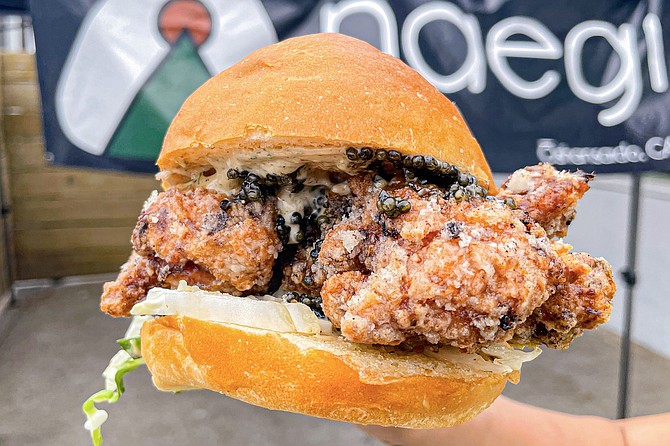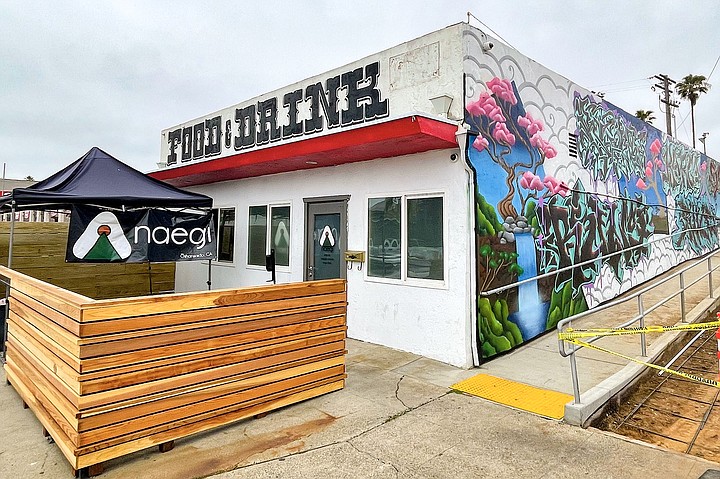 Facebook
Facebook
 X
X
 Instagram
Instagram
 TikTok
TikTok
 Youtube
Youtube

Elaborate, green and black graffitied monikers float like crumpled leaves through a landscape of clouded mountain peaks, pink cherry blossoms, and blue waterfalls. The vibrant mural covers the broad, flat side wall of stand-alone storefront, a block west of the Coast Highway (626 South Tremont Street, Oceanside). The product of a recent live art performance, its more colorful elements were added in deference to the building’s imminent future as a Japanese fine dining restaurant, Matsu.

But first, this summer only, it’s a fried chicken pop-up restaurant called Naegi. And not only does Naegi offer the best fried chicken sandwich in the county (for $8) — for an extra $20, you can make it the most indulgent chicken sandwich in the county, thanks to the option to add sturgeon caviar.
Both Matsu and Naegi concepts are the work of Oceanside chef William Eick, last seen a year ago providing fried chicken meals to food insecure residents from his kitchen post at Mission Avenue Grill. That’s where a growing interest in Japanese cuisine prompted Eick to introduce the Matsu concept, as a prix fixe pop-up restaurant charging $120 per person.
Two years later, the upscale Matsu (what the Japanese call a pine tree) is waiting on an alcohol license, and will open as soon as late August or September. Until it does, Eick will use its kitchen to operate Naegi (Japanese for: sapling).
Though Naegi is only at this property temporarily, Eick has wider plans for the casual concept and is actively seeking multiple locations for it around San Diego (though the proud local is determined to launch first in Oceanside). The restaurant’s focus is karaage, better known as the Japanese fried chicken familiar from many a ramen and sushi menu.
At Naegi, this means marinating chicken in a shio blend of koji and shoyu for up to three days, prior to frying in a crisp potato starch crust. You can order a whole bird for $29, or order chicken pieces of your choice: a single breast ($8), or pairs of thighs ($7), legs ($7) and wings ($7).
The $8 “famous karaage sando” features a thigh, dressed with togarashi mayo and cabbage on house-baked Hokkaido milk bun. If you’re not feeling chicken, sandwiches also feature the likes of fried tofu ($7) and shrimp ($9). If you’re not feeling fried food, you may opt for egg salad ($5) or kanikama (a.k.a. krab).
You may add caviar to any of them, but I cannot argue skipping the fried chicken. The meat inside is surprisingly succulent and tender, while the starchy exterior adds crunch and a seasoning that offers more complex umami notes than the southern fried and Nashville hot chicken styles that currently dominate San Diego’s fowl cravings.
As for the caviar it adds an ocean essence to the sandwich, boosting the salinity in creating a palate that is unmistakably Japanese. Like caviar itself, it could easily become an addiction. It turns out Eick acts as ambassador for Sterling Caviar, a brand out of Northern California. It will be a fixture on Matsu’s menu, and he told me the idea to put sturgeon roe on his Naegi sandwiches is mainly about priming the Oceanside community to associate this building as a place where caviar is served.
Caviar may or may not travel with future Naegi locations, but for the time being, the 20-dollar add-on may be the cheapest way to experience the fish roe delicacy. Sterling’s caviar starts at $90 per ounce, and when New York City chef David Chang famously made caviar available with fried chicken at his restaurant, Momofuku, he charged $500.
By comparison, this highbrow ingredient on a casual dish combination looks too good to pass up at $28. Get it soon — it’ll be gone by end of summer.


Elaborate, green and black graffitied monikers float like crumpled leaves through a landscape of clouded mountain peaks, pink cherry blossoms, and blue waterfalls. The vibrant mural covers the broad, flat side wall of stand-alone storefront, a block west of the Coast Highway (626 South Tremont Street, Oceanside). The product of a recent live art performance, its more colorful elements were added in deference to the building’s imminent future as a Japanese fine dining restaurant, Matsu.

But first, this summer only, it’s a fried chicken pop-up restaurant called Naegi. And not only does Naegi offer the best fried chicken sandwich in the county (for $8) — for an extra $20, you can make it the most indulgent chicken sandwich in the county, thanks to the option to add sturgeon caviar.
Both Matsu and Naegi concepts are the work of Oceanside chef William Eick, last seen a year ago providing fried chicken meals to food insecure residents from his kitchen post at Mission Avenue Grill. That’s where a growing interest in Japanese cuisine prompted Eick to introduce the Matsu concept, as a prix fixe pop-up restaurant charging $120 per person.
Two years later, the upscale Matsu (what the Japanese call a pine tree) is waiting on an alcohol license, and will open as soon as late August or September. Until it does, Eick will use its kitchen to operate Naegi (Japanese for: sapling).
Though Naegi is only at this property temporarily, Eick has wider plans for the casual concept and is actively seeking multiple locations for it around San Diego (though the proud local is determined to launch first in Oceanside). The restaurant’s focus is karaage, better known as the Japanese fried chicken familiar from many a ramen and sushi menu.
At Naegi, this means marinating chicken in a shio blend of koji and shoyu for up to three days, prior to frying in a crisp potato starch crust. You can order a whole bird for $29, or order chicken pieces of your choice: a single breast ($8), or pairs of thighs ($7), legs ($7) and wings ($7).
The $8 “famous karaage sando” features a thigh, dressed with togarashi mayo and cabbage on house-baked Hokkaido milk bun. If you’re not feeling chicken, sandwiches also feature the likes of fried tofu ($7) and shrimp ($9). If you’re not feeling fried food, you may opt for egg salad ($5) or kanikama (a.k.a. krab).
You may add caviar to any of them, but I cannot argue skipping the fried chicken. The meat inside is surprisingly succulent and tender, while the starchy exterior adds crunch and a seasoning that offers more complex umami notes than the southern fried and Nashville hot chicken styles that currently dominate San Diego’s fowl cravings.
As for the caviar it adds an ocean essence to the sandwich, boosting the salinity in creating a palate that is unmistakably Japanese. Like caviar itself, it could easily become an addiction. It turns out Eick acts as ambassador for Sterling Caviar, a brand out of Northern California. It will be a fixture on Matsu’s menu, and he told me the idea to put sturgeon roe on his Naegi sandwiches is mainly about priming the Oceanside community to associate this building as a place where caviar is served.
Caviar may or may not travel with future Naegi locations, but for the time being, the 20-dollar add-on may be the cheapest way to experience the fish roe delicacy. Sterling’s caviar starts at $90 per ounce, and when New York City chef David Chang famously made caviar available with fried chicken at his restaurant, Momofuku, he charged $500.
By comparison, this highbrow ingredient on a casual dish combination looks too good to pass up at $28. Get it soon — it’ll be gone by end of summer.
Comments